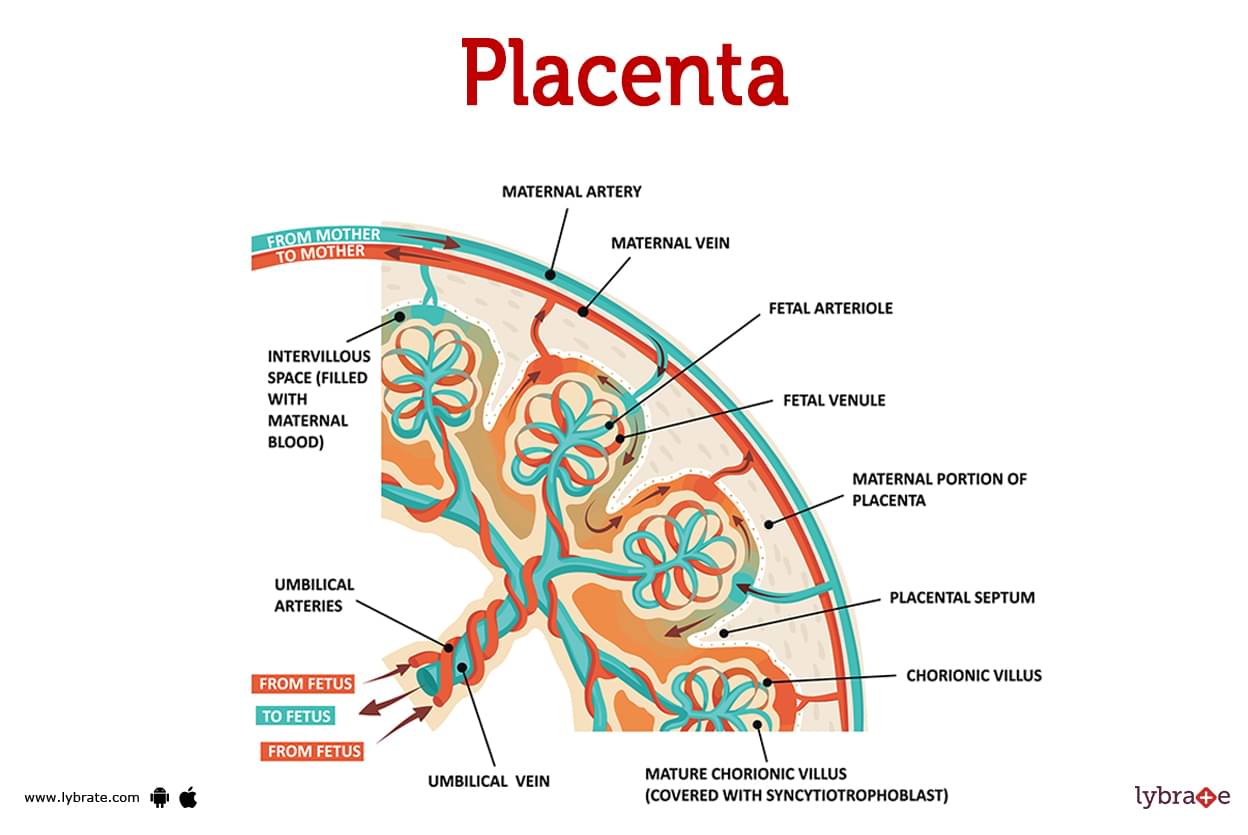Placenta (Female Anatomy): Image, Functions, Diseases and Treatments
Last Updated: Nov 28, 2022
Placenta Image
An ephemeral organ, the placenta develops in the uterus during pregnancy. It attaches to your uterine wall and uses the umbilical cord to provide food and oxygen to your unborn child. Pregnancy issues might arise as a consequence of certain placental abnormalities. In the uterus, the placenta develops throughout pregnancy. It provides the foetus with nutrition and oxygen.
What is the placenta?
During pregnancy, the placenta is a short-lived organ that links your child to your uterus. Soon after you get pregnant, the placenta grows and sticks to the surface of your uterus. The umbilical cord is the link between your baby and the placenta. Your baby's lifeline while in the womb is the placenta and the umbilical cord. It helps bring life-giving air and nourishment to your infant and cleans your infant's air of dangerous gases and garbage. Additionally, it helps your baby develop by secreting hormones. It transfers immunity from you to your infant. It's good for the baby's safety.
When does the placenta form?
Following an egg has been fertilised and implanted in the uterus, the process of placental development can take anywhere from seven to ten days after conception. It maintains its growth during your pregnancy in order to provide support for your unborn child. The placenta develops from a small number of cells into a structure that is several inches in length.
When exactly does the placenta begin to take control?
By the time the first trimester is over, the placenta has taken over the manufacturing of hormones (12 weeks of pregnancy). The corpus luteum was responsible for the majority of hormone synthesis up until this point. When the placenta begins to take over in the second trimester, many women no longer experience the nausea and lethargy that they did in the first trimester.
Does the placenta move?
Kind of, The placenta seems to move as the pregnancy develops and the baby grows as the uterus swells. Your healthcare provider will assess the location of your placenta during your 20-week anatomy ultrasound to see if it might pose problems. Most placentas have migrated to the topmost of the uterus by 32 weeks.
Where does the placenta form?
In the uterus, the placenta may develop in any of many different locations. Your foetus will grow in the area of your uterus where the fertilised egg implanted. Among the placenta's possible locations are:
- Posterior Placenta: It forms on the uterus's posterior wall.
- Anterior Placenta: develops on the uterine wall anterior to the abdominal cavity.
- Fundal Placenta: The placenta develops at the top of the uterus.
- Lateral Placenta: When the placenta develops on the side of the uterus, it is said to be lateral.
As late as week 32 of pregnancy, the placenta may be transferred. As your baby grows, it's normal for the placenta to shift higher and farther from your cervix.
What does the placenta look like?
At full maturity, the placenta has the appearance of a disc of rough tissue that is abundant in blood veins, giving it a dark red colour. The mature placenta is mostly comprised of blood vessels as its tissue composition. They are linked to the infant by the umbilical cord and spread out like branches over the placenta disc in a manner similar to that of a tree.
What colour is the placenta?
The two sides of the placenta are the side that is attached to your uterus and the side that is closest to your infant. The side that connects to your uterine wall is dark reddish blue in colour, while the side that faces your baby is grey.
How big is a normal placenta?
The placenta measures 10 inches in length and 1 inch in thickness in the middle. By the time the baby is born, it usually weighs about 1 pound and 16 ounces.
What is the placenta made of?
When an egg is fertilized into your uterine wall, the placenta starts to develop. The placenta is mostly made up of blood vessels housed in structures known as 'villi.' Through the umbilical cord, the blood vessels link to the baby's bloodstream. The remaining placental tissues primarily link the villi to the umbilical cord and enable the blood to bathe the villi, providing the child with oxygen and nutrients.
Placenta Functions
During pregnancy, the placenta plays an important role in maintaining the baby's life and health. Your placenta absorbs oxygen, glucose, and other nutrients from your blood, which then travels through the placenta and into the umbilical cord, where it is delivered to your baby. Additionally, the placenta has the ability to remove toxic carbon dioxide and waste materials from the blood of your baby. The placenta allows for the transfer of oxygen and nutrients from your bloodstream to that of your baby's bloodstream without ever mixing the two bloodstreams together. It performs the functions of the baby's lungs, kidneys, and liver until the baby is born.
As you near birth, the placenta sends antibodies to your baby to help it develop immunity. This immunity stays with your infant throughout the first few months of life.The placenta produces many important hormones during pregnancy, including lactogen, estrogen, and progesterone. These pregnancy hormones are beneficial for both you and your unborn child. For instance, during pregnancy, the placenta produces a hormone that reduces milk production.
Conditions And Disorders
- Preeclampsia: Another placental condition is preeclampsia, a pregnancy complication that may cause high blood pressure and potential renal damage. Its signs include rapid weight gain, swollen hands, legs, and fingers, as well as headaches.
- Placenta previa: The cervix, or entrance to the uterus, is blocked whole or partly by the placenta. This is a problem since a vaginal delivery involves the infant passing through both the cervix and the birth canal. After twenty weeks, this disorder usually starts to show symptoms, such as pains and bleeding.
- Placental abruption: When the placenta prematurely breaks from the uterine wall, it causes a very hazardous situation for both the mother and the unborn child. This might obstruct the baby's access to oxygen and nutrition, limiting its ability to develop, or even causing a preterm or stillbirth delivery.
- Placenta Accreta Spectrum: The placenta may sometimes cling to the uterus too strongly. It is known as a placenta accreta if it extends too far into the uterus. It could even wrap over the rectum or possibly the bladder.
- Placental insufficiency: Foetal growth limitation and potential developmental problems may result from placental insufficiency, which occurs when the placenta is unable to provide the foetus with adequate oxygen and nutrients. The placenta's improper attachment to the uterus prevents the arteries from widening and inhibits the supply of vital nutrients and oxygen, which leads to insufficiency.
- RPOC: Retained products of conception, also known as RPOC, are placental or foetal tissues that are still in your uterus after giving birth. When a pregnancy terminates prematurely, RPOC is more frequent. Bleeding, infections, and other issues may result with RPOC.
- Chronic histiocytic intervillositis: An exceedingly uncommon illness called chronic histiocytic intervillositis (CHI) has the potential to harm the placenta during pregnancy. In CHI, the placenta is damaged as a result of the mother's immune system's aberrant response to the pregnancy, raising the risk of stillbirth and miscarriage.
- Foetal Growth Retardation: It is a condition where a baby's growth slows or stops while the mother is pregnant. Although placental failure accounts for the majority of FGR instances, there are other causes as well, such as intrauterine infection and pregnancy-related smoking.
- Vasa praevia: Blood veins from the umbilical cord penetrate straight into the placenta in the majority of pregnancies. These vessels are not covered by the placenta or the umbilical cord in vasa praevia. Instead, they pass across the opening to the birth canal while the child is still within.
What are the most common signs of a placenta disorder?
You will typically bleed from your vagina if the placenta isn't functioning properly. It's crucial to discuss your symptoms with your healthcare professional since not every pregnant woman bleeds. Additional symptoms of a placenta problem include stomach pain and contractions. A placenta issue might be the cause of a baby that is smaller than expected for its due date.
Placenta Tests
- Ultrasonography: placenta previa may be identified during a regular prenatal visit or during a bout of vaginal bleeding with the help of usg.
- Alpha-fetoprotein test: An AFP test is primarily used to assess a pregnant person's blood's level of alpha-fetoprotein (AFP). The test assesses the likelihood that the child will have specific genetic conditions and birth abnormalities.
- Biopsy: A sample of placental tissue must be taken for the placenta blood test. The genetic makeup of this tissue often matches that of the foetus. It may be examined for chromosomal issues as well as a few other genetic issues. If you have a family history of these conditions, the test may also screen for other genetic issues and illnesses.
- Placenta chorion test: The placenta chorion test is used to identify genetic disorders and/or abnormalities in developing foetuses.
Placenta Treatments
- Caesarean hysterectomy: This procedure aids in avoiding the potentially fatal blood loss that may result from attempting to separate the placenta.
- Blood transfusion: This may be given if there is a loss of large amounts of blood. Blood is given through an IV.
Placenta Medicines
- Steroids for reducing inflammation of Placenta: Corticosteroids are prescribed to promote development of the baby's lungs before delivery. sopme of the examples of corticosteroids includes dexamethasone and betamethasone. also medicines in form of hydrocortisone are also useful.
- Analgesics for pain in Placenta: when there is rupture of placenta occurence of pain is the primary symptom fopr which medicines like diclofenac sodium, paracetamol and naproxen sodium are known to be useful. also drugs like tramodol hydrocholirode are also used.
- Antibiotics for infection in Placenta: whenever there is infection in maternal side there are chacnes of infection in the placenta so in these situations the antibiotics like ceftriaxone, amplicillin and sulbactum are also useful.
- Nutritional supplements for reducing pain in Placenta: supplements like vitamin d, calcium, cyanocobalamin are also useful whenver there is the event of pregnancy.
- Antivirals for treating infection of Placenta: if there is risk of any of the TORCH infection i.e. toxoplasma, rubella, herpes, chlamydia the antivirals like remedesvir, acyclovir, gancyclovir are known to be useful.
- Anticonvulsant: medication such as magnesium sulphate is usually prescribed to prevent seizures.
- Hemocoagulationfor stopping bleeding: Tranexamic acid prevents enzymes in the body from breaking down blood clots.
Table of content
Find Gynaecologist near me
Ask a free question
Get FREE multiple opinions from Doctors



